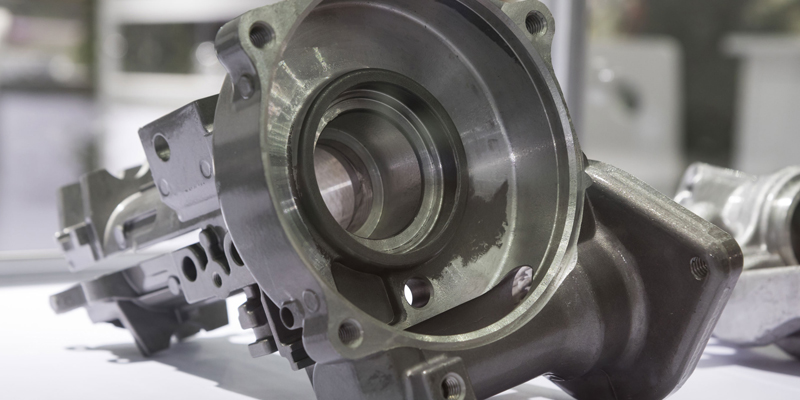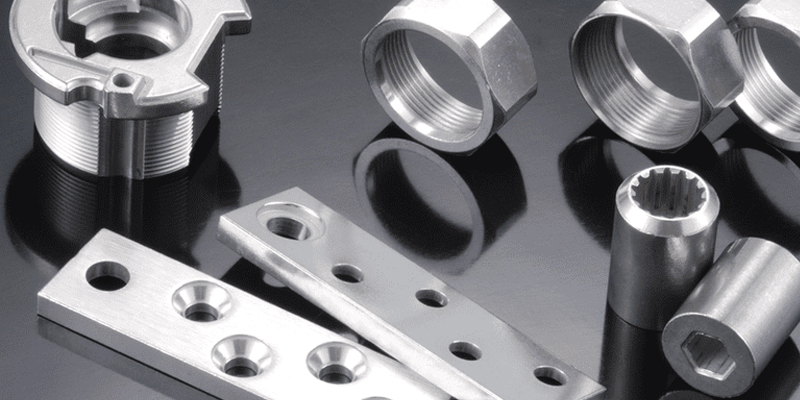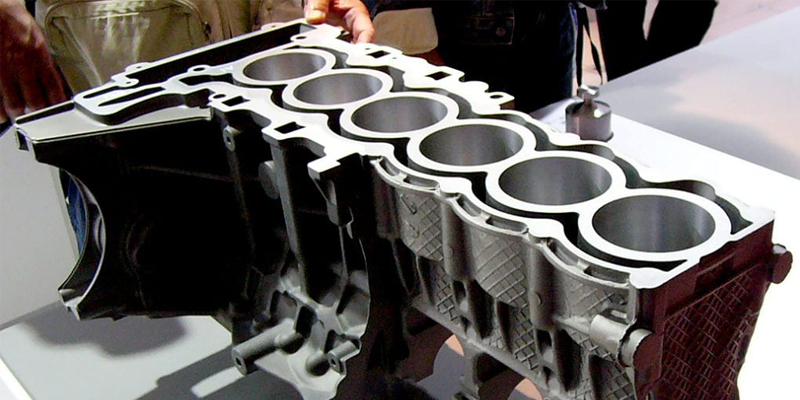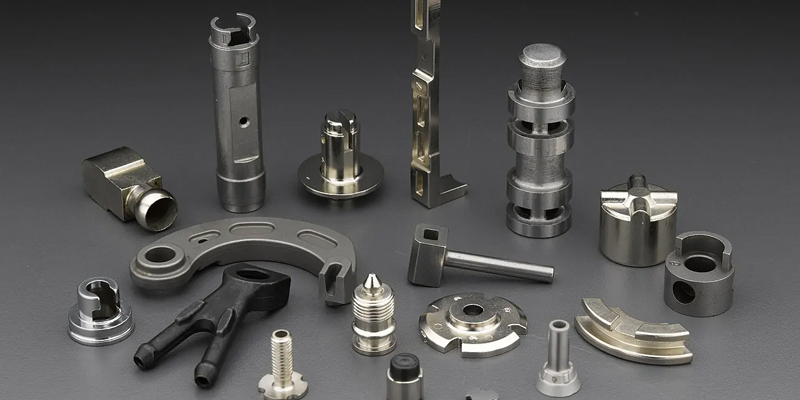What is die casting ,what is metal injection moulding?
Die Casting:
Die casting is a manufacturing process used to produce metal parts with high precision and surface finish. It involves the following steps:
Mold Preparation: A metal mold (die) is created in the desired shape of the part. This mold consists of two halves, the "die" and the "core," which form the part's cavity when closed together.
Melting and Injection: Metal, often aluminum, zinc, or magnesium, is melted in a furnace and then injected into the mold under high pressure. The pressure ensures that the metal fills the mold cavity completely.
Cooling and Solidification: After injection, the metal rapidly cools and solidifies within the mold. This results in a near-net-shape part with high dimensional accuracy.
Ejection: The mold is opened, and the finished part is ejected from it.
Trimming and Finishing: The part may require trimming, deburring, and other finishing operations to meet the final design specifications and surface finish requirements.
Die casting is commonly used for producing parts for industries such as automotive, aerospace, and consumer electronics. It offers excellent dimensional accuracy and can be highly automated for large-scale production.
Metal Injection Molding (MIM):
Metal Injection Molding is a manufacturing process that combines the principles of plastic injection molding with powdered metallurgy. It is used to produce small, complex, and highly detailed metal parts. Involves the following steps:
Feedstock Preparation: Fine metal powder is mixed with a thermoplastic binder material to create a feedstock. This mixture has a consistency similar to that of toothpaste.
Injection Molding: The feedstock is heated and injected into a mold cavity under pressure. It takes the shape of the mold cavity.
Debinding: After molding, the part is subjected to a debinding process to remove most of the binder material. This leaves behind a "green" part consisting of metal powder particles held together by residual binder.
Sintering: The green part is sintered in a high-temperature furnace. During sintering, the metal particles fuse together, the remaining binder is removed, and the part densifies. The result is a solid metal part.
Finishing: Post-processing steps such as machining, heat treatment, and surface finishing may be required to achieve the final part specifications.
MIM is known for its ability to produce intricate and complex parts with high precision and material diversity, making it suitable for industries like medical devices, firearms, and electronics, where small, complex components are needed. However, metal injection moulding is often more expensive and time-consuming than die casting, making it most cost-effective for lower to moderate production volumes or when intricate designs are essential.
Comparison of their material applications
Die casting and metal injection molding (MIM) are suitable for different material applications due to their respective processes and capabilities.
Die Casting:
1. Aluminum Alloys: Die casting is commonly used for various aluminum alloy applications. Aluminum die-cast parts are lightweight and offer good strength-to-weight ratios, making them ideal for automotive components, consumer electronics, and aerospace parts.
2. Zinc Alloys: Zinc die casting is popular for applications requiring excellent corrosion resistance, such as plumbing fixtures, electrical connectors, and decorative hardware.
3. Magnesium Alloys: Die casting can be employed with magnesium alloys for lightweight, high-strength components used in automotive and aerospace industries.
4. Copper Alloys: Some die casting applications use copper-based alloys, which provide good electrical conductivity. These applications include electrical connectors and components for the electronics industry.
5. Other Alloys: While less common, die casting can also accommodate other alloys like brass and lead-based alloys for specific applications.
6. Ferrous Alloys: In certain cases, ferrous alloys can be used in die casting, although it's less common due to the high temperatures involved in the process.
7. Material Combinations: Die casting can produce parts with material combinations, such as overmolding, where multiple materials are combined in a single part.

Metal Injection Molding (MIM):
1. Stainless Steel: MIM is often used for stainless steel applications due to its corrosion resistance and high strength. It's common in medical devices, firearms, and aerospace components.
2. Low Alloy Steel: Low alloy steels are used in MIM for parts that require specific mechanical properties, such as gears, sprockets, and structural components.
3. Tool Steels: MIM is suitable for producing tool steels used in cutting tools, molds, and other high-wear applications.
4. Titanium Alloys: Titanium MIM components find applications in aerospace, medical implants, and sports equipment, thanks to their strength-to-weight ratio and biocompatibility.
5. Cobalt-Chromium Alloys: These alloys are used in MIM for medical and dental implants due to their biocompatibility and corrosion resistance.
6. Superalloys: MIM can process superalloys like Inconel and Hastelloy for demanding applications in aerospace and chemical processing.
7. Tungsten and Tungsten Alloys: MIM is used for tungsten and its alloys in applications requiring high-density components, such as radiation shielding and aerospace.
8. Cermet Composites: MIM can produce cermet materials, which combine ceramics and metals, for specialized applications like cutting tools and wear-resistant components.
9. Other Materials: MIM can work with a wide range of materials, including copper, nickel, and various alloys, offering versatility for custom applications.
Die casting is well-suited for non-ferrous alloys like aluminum, zinc, and magnesium, along with certain copper-based alloys, while MIM is highly versatile and suitable for a broader range of materials, including stainless steel, titanium, cobalt-chromium, superalloys, and even some ceramics.

What scenarios are Die Casting and Metal Injection Molding (MIM) used in?
Die casting and metal injection molding (MIM) have different application scenarios based on their capabilities and characteristics.
Die casting:
Die casting is widely used in the automotive industry because of its high productivity and durability, and is used to produce components such as engine blocks, transmission housings, rims, and a variety of other structural and decorative parts.
l Consumer Electronics:
Die casting technology is used to manufacture metal cases and housings for products such as smartphones, laptops and other electronic devices that require a high degree of precision, durability and aesthetics.
Aircraft and aerospace applications benefit from die casting technology for components such as aircraft engine parts, fuselage parts and lightweight structural components.
l Industrial Machinery:
Die casting is used to produce heavy mechanical components such as pumps, hydraulic components and industrial equipment components.
l Lighting:
Used in the manufacture of lighting fixtures, lamp bases and other decorative and functional lighting components.
l TOYS AND RECREATIONAL EQUIPMENT:
Die casting can be used to produce metal parts in toys, sporting goods and recreational equipment, such as bicycle parts and parts for toys and game consoles.
Metal Injection Molding (MIM):
Metal injection molding is commonly used in the medical industry to produce small, complex parts such as surgical instruments, orthodontic brackets and dental implants due to its high precision and material versatility.
l Electronics:
Metal injection molding is used to manufacture small, complex connectors, sensor housings and other electronic components that require high levels of size and precision.
l Firearms and Defense:
MIM is used to produce firearms components such as triggers and sights, as well as small parts where dimensional accuracy and complex design are critical.
l Watches and Jewelry:
MIM is used to manufacture intricate and detailed watch parts and jewelry, including watch hands, clasps, and other fine components.
l Automotive and Aerospace:
While die casting is more common in these industries, MIM can be used to produce smaller, more delicate parts such as sensors, injectors and brackets.
l General Small Parts:
Metal Injection Molding is used to produce a variety of small, complex parts, including gears, fasteners, and hinges, for a wide range of industries.
l Fire Sprinkler Systems:
MIM can be used to manufacture complex fire sprinkler components for fire protection systems.
Die casting is well suited for applications requiring larger, stronger metal parts with simpler geometries, while metal injection molding excels at producing smaller, complex and highly detailed metal parts.
Tolerances and surface finish can vary significantly between die casting and metal injection molding (MIM) due to the nature of these two manufacturing processes.
Die Casting:

Tolerances:
Die casting can achieve relatively tight tolerances, typically in the range of ±0.005 to ±0.02 inches (0.127 to 0.508 mm), depending on part size and complexity.
Highly complex or critical parts may require additional machining to achieve tighter tolerances.
Surface Finish:
Die casting can produce parts with a good surface finish, typically ranging from 32 to 125 microinches (0.8 to 3.2 micrometers) Ra. This finish is suitable for many applications without additional surface treatment.
Surface finish can be further improved with post-processing operations such as polishing, shot blasting, or coating.
Metal Injection Molding (MIM):

Tolerances:
MIM is capable of achieving excellent tolerances, often in the range of ±0.001 to ±0.003 inches (0.025 to 0.076 mm), even for very small and complex parts.
The process allows for precise replication of intricate features and tight dimensional control.
Surface Finish:
MIM parts typically have a surface finish that ranges from 16 to 64 microinches (0.4 to 1.6 micrometers) Ra, which is generally smoother than die-cast parts.
The fine surface finish is a result of the sintering process, which compacts and densifies the metal particles.
MIM generally offers superior dimensional accuracy and finer surface finish compared to die casting. MIM's ability to replicate intricate details and achieve tight tolerances makes it suitable for applications where precision is critical, such as in the medical, aerospace, and electronics industries. Die casting, while also capable of meeting high tolerances and surface finish requirements, is more commonly used for larger and less complex parts or applications where speed and cost-efficiency are paramount. Post-processing operations can further improve surface finish and tolerances for both processes when necessary.
Comparison of their advantage & disadvantage:
Strengths of Die Casting:
(1) High Production Efficiency: Die casting is well-suited for high-volume production. It has relatively short cycle times, making it efficient for mass production of parts.
(2) Excellent Mechanical Properties: Die-cast parts typically exhibit high mechanical strength and durability. This makes them suitable for structural components in automotive, aerospace, and industrial applications.
(3) Surface Finish: Die casting can achieve good surface finish, often without the need for additional post-processing, making it suitable for parts with aesthetic requirements.
(4) Material Versatility: Die casting can work with various metals, including aluminum, zinc, magnesium, and some other alloys, providing flexibility in material selection.
(5) Dimensional Accuracy: Die casting can achieve tight tolerances, especially with precision tooling, ensuring parts meet strict dimensional requirements.
(6) Cost-Effective for Large Volumes: Due to its high production efficiency, die casting is cost-effective for large production runs, reducing per-unit costs.
Disadvantages of Die Casting:
(1) Limited Complexity: Die casting is less suitable for parts with highly intricate or complex geometries. The process is better suited for simpler shapes.
(2) Higher Initial Tooling Costs: Creating the molds (dies) for die casting can be expensive and time-consuming, making it less cost-effective for low-volume production.
(3) Material Restrictions: Die casting is limited to metals and alloys that can withstand the high temperatures and pressures involved in the process. Some materials may not be suitable.
(4) Porosity: Die-cast parts can exhibit porosity, which may affect their mechanical properties. Additional processes like heat treatment may be required to mitigate this issue.
(5) Surface Imperfections: Despite achieving good surface finishes, die-cast parts may still have surface imperfections like flash or parting lines that require post-processing.
(6) Size Limitations: Die casting is generally not suitable for very large parts due to the limitations of the casting equipment.
(7) Design Flexibility: Design changes in die casting molds can be costly and time-consuming, making it less flexible for rapidly evolving designs.
Strengths of Metal Injection Molding (MIM):
(1) Complex Geometry: MIM excels in producing parts with complex geometries, intricate details, and fine features that may be challenging or impossible to achieve with die casting.
(2) High Precision: MIM offers exceptional dimensional accuracy, making it suitable for applications where precision is critical, such as medical devices, electronics, and aerospace components.
(3) Wide Material Range: MIM can work with a broader range of materials, including stainless steel, titanium, and superalloys, allowing for material selection to meet specific performance requirements.
(4) Reduced Material Waste: MIM generates less material waste compared to traditional machining processes, as excess material can often be recycled.
(5) Low to Moderate Volume Production: MIM is cost-effective for low to moderate production volumes, making it suitable for niche markets and specialized applications.
(6) Near-Net Shape: MIM produces parts close to their final shape, reducing the need for extensive post-processing, which can be advantageous for cost and time savings.
(7) Design Flexibility: MIM allows for design flexibility and consolidation of multiple parts into a single component, reducing assembly requirements.
Disadvantages of Metal Injection Molding (MIM):
(1) Higher Material Costs: MIM feedstock materials, especially metal powders, can be more expensive than bulk materials used in other processes, increasing overall part costs.
(2) Complex Process: MIM involves multiple steps, including debinding and sintering, which can be complex and time-consuming.
(3) Limited to Small to Moderate Volumes: MIM is typically not as cost-effective as die casting for high-volume production due to its longer cycle times and material costs.
(4) Tight Tolerances May Require Additional Machining: While MIM can achieve tight tolerances, achieving the tightest tolerances may require additional machining, adding time and cost.
(5) Limited to Metallic Materials: MIM is primarily used for metallic materials, so it may not be suitable for applications that require non-metallic materials.
(6) Green Part Fragility: The "green" MIM parts (after molding but before sintering) are fragile and require careful handling to prevent breakage.
(7) Environmental Considerations: The debinding process in MIM can involve the use of organic solvents, which may have environmental and safety implications.
(8) Tooling Costs: While MIM has lower tooling costs compared to die casting, it still requires tooling for mold cavities, which can be a significant upfront expense.
Summary:
Die casting and metal injection molding (MIM) are two distinct manufacturing processes used to produce metal parts with different characteristics.
Die Casting: Die casting is a metal casting process that involves injecting molten metal into a mold cavity at high pressure. The metal solidifies and takes the shape of the mold cavity, resulting in a near-net-shape part.
Metal Injection Molding (MIM): MIM is a powder metallurgy process that combines the advantages of plastic injection molding with the ability to create intricate metal parts. It involves mixing finely powdered metal with a binder material to create a feedstock, which is then injection-molded into a mold cavity. After molding, the part goes through a debinding and sintering process to remove the binder and densify the metal particles.
Complexity and Design Flexibility:
Die Casting: Die casting is better suited for parts with simpler geometries, although it can produce intricate designs with the use of secondary operations like machining.
Metal Injection Molding (MIM): MIM excels at producing highly complex and intricate parts with fine details, making it ideal for applications where design flexibility is crucial.
Material Selection:
Die Casting: Die casting is commonly used for materials like aluminum, zinc, and magnesium, but it can also be used for some other metals. However, it may not be suitable for all metals due to the high temperatures involved.
Metal Injection Molding (MIM): MIM can work with a broader range of metals, including stainless steel, titanium, and various alloys. This makes it versatile for different material requirements.
Tolerance and Surface Finish:
Die Casting: Die casting typically offers better dimensional accuracy and surface finish compared to MIM. Parts often require minimal post-processing.
Metal Injection Molding (MIM): MIM parts may require more post-processing to achieve the desired tolerances and surface finish, especially for intricate designs.
Production Volume:
Die Casting: Die casting is generally more suitable for high-volume production due to its faster cycle times and efficiency.
Metal Injection Molding (MIM): MIM is better suited for lower to moderate production volumes due to longer cycle times and tooling costs.
Cost Considerations:
Die Casting: Die casting molds are expensive to create but are cost-effective for large production runs.
Metal Injection Molding (MIM): MIM has higher tooling costs and material costs but can be cost-effective for smaller production quantities or when complex geometries are required.
Lead Times:
Die Casting: Die casting tooling often has longer lead times for design and fabrication.
Metal Injection Molding (MIM): MIM tooling lead times can be shorter, making it a quicker option for prototype or low-volume production.
Die casting and metal injection molding are both valuable manufacturing processes, but they are suitable for different applications. Die casting is ideal for simpler shapes and high-volume production, while MIM excels in producing complex, high-precision parts with a wide range of materials, making it a preferred choice for specialized and intricate components.
Choose the GD-HUB to start your die casting/metal injection molding project.